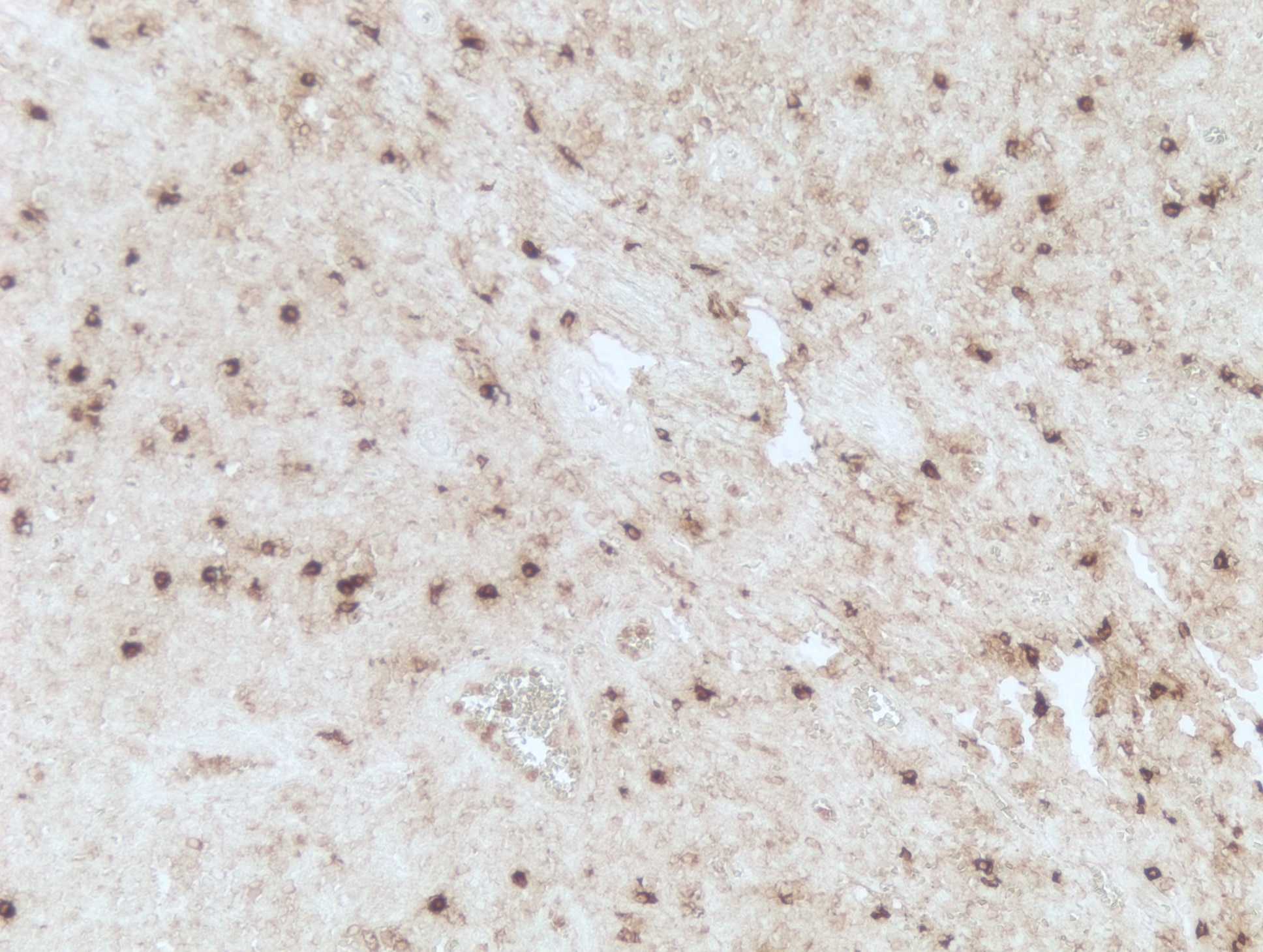Siglec-3/CD33 Antibody (996810) [Unconjugated] Summary
| Immunogen |
Mouse myeloma cell line, NS0-derived human Siglec-3/CD33
Asp18-His259
Accession # P20138 |
| Specificity |
Detects human Siglec-3/CD33 in direct ELISAs. |
| Source |
N/A |
| Isotype |
IgG2b |
| Clonality |
Monoclonal |
| Host |
Mouse |
| Purity Statement |
Protein A or G purified from hybridoma culture supernatant |
| Innovator's Reward |
Test in a species/application not listed above to receive a full credit towards a future purchase. |
Applications/Dilutions
| Dilutions |
- Immunocytochemistry 8-25 ug/mL
- Immunohistochemistry 5-25 ug/mL
- Western Blot 2 ug/mL
|
| Reviewed Applications |
Read 1 Review rated 4 using
MAB11371 in the following applications:
|
|
| Publications |
|
Packaging, Storage & Formulations
| Storage |
Use a manual defrost freezer and avoid repeated freeze-thaw cycles. - 12 months from date of receipt, -20 to -70 °C as supplied.
- 1 month, 2 to 8 °C under sterile conditions after reconstitution.
- 6 months, -20 to -70 °C under sterile conditions after reconstitution.
|
| Buffer |
Lyophilized from a 0.2 μm filtered solution in PBS with Trehalose. *Small pack size (SP) is supplied either lyophilized or as a 0.2 µm filtered solution in PBS. |
| Reconstitution Instructions |
Reconstitute at 0.5 mg/mL in sterile PBS. |
Notes
This product is produced by and ships from R&D Systems, Inc., a Bio-Techne brand.
Alternate Names for Siglec-3/CD33 Antibody (996810) [Unconjugated]
Background
Siglecs (sialic acid binding Ig-like lectins) are I-type (Ig-type) lectins belonging to the Ig superfamily. They are characterized by an N‑terminal Ig-like V-type domain which mediates sialic acid binding, followed by varying numbers of Ig-like C2-type domains (1, 2). Eleven human Siglecs have been cloned and characterized. They are sialoadhesin/CD169/Siglec-1, CD22/Siglec-2, CD33/Siglec-3, Myelin-Associated Glycoprotein (MAG/Siglec-4a) and Siglecs 5 to 11 (1‑3). To date, no Siglec has been shown to recognized any cell surface ligand other than sialic acids, suggesting that interactions with glycans containing this carbohydrate are important in mediating the biological functions of Siglecs. Siglecs 5 to 11 share a high degree of sequence similarity with CD33/Siglec-3 both in their extracellular and intracellular regions. They are collectively referred to as CD33-related Siglecs. One remarkable feature of the CD33-related Siglecs is their differential expression pattern within the hematopoietic system (1, 2). This fact, together with the presence of two conserved immunoreceptor tyrosine-based inhibition motifs (ITIMs) in their cytoplasma tails, suggests that CD33-related Siglecs are involved in the regulation of cellular activation within the immune system.
Human Siglec-3 is alternatively known as myeloid cell surface antigen CD33 and GP67. Human Siglec-3 cDNA encodes a 364 amino acid (aa) polypeptide with a hydrophobic signal peptide, an N-terminal Ig-like V-type domain, one Ig-like C2-type domains, a transmembrane region and a cytoplasmic tail (1, 4). Siglec-3 expression is restricted to cells of myelomonocytic lineage (2). It binds sialic acid preferring alpha 2,3- linkage over alpha 2,6- linkage (5). Studies indicated that Siglec-3 recruits SHP-1 and SHP-2 to its ITIMs (6, 7). When co-crosslinking with Fc gamma R1, Siglec-3 inhibits tyrosine phosphorylation and calcium mobilization, suggesting Siglec-3 can mediate inhibitory signals (7).
- Crocker, P.R. and A. Varki (2001) Trends Immunol. 22:337.
- Crocker, P.R. and A. Varki (2001) Immunology 103:137.
- Angata, T. et al. (2002) J. Biol. Chem. 277:24466.
- Simmons, D. and B. Seed (1988) J. Immunol. 141:2797.
- Freeman, S.D. et al. (1995) Blood 85:2002.
- Taylor, V.C. et al. (1999) J. Biol. Chem. 274:11505.
- Ulyanova, T. et al. (1999) Eur. J. Immunol. 29:3440.
Limitations
This product is for research use only and is not approved for use in humans or in clinical diagnosis. Primary Antibodies are
guaranteed for 1 year from date of receipt.
Customers Who Viewed This Item Also Viewed...
Species: Hu
Applications: BA
Species: Hu
Applications: CyTOF-ready, ELISA, Flow, ICC/IF, IHC, IHC-P, PA, WB
Species: Hu, Mu
Applications: Flow-IC, Flow, ICC/IF, IHC, IHC-Fr, IHC-P, IP, WB
Species: Rt
Applications: IHC, WB
Species: Mu
Applications: CyTOF-ready, Flow, ICC, IHC, IP, WB
Species: Hu
Applications: ELISA
Species: Hu, Mu, Rt
Applications: ICC/IF, WB
Species: Hu
Applications: CyTOF-ready, ELISA, Flow, IMC, IHC, IHC-P, WB
Species: Hu, Mu
Applications: CyTOF-ready, Flow, ICC/IF, In vitro, WB
Species: Hu
Applications: ICC, IHC, WB
Species: Hu
Applications: Flow, ICC/IF, IHC, IHC-P, PEP-ELISA, WB
Species: Hu
Applications: ICC, IHC, WB
Species: Hu
Applications: ICC/IF, IHC, IHC-P
Species: Hu
Applications: ICC/IF, IHC, IHC-P, WB
Species: Mu
Applications: ELISA(Cap), ELISA(Det), ELISA(Sta), IHC, IP, WB
Species: Hu, Mu
Applications: Dual ISH-IHC, ICC, IHC, Simple Western, WB
Species: Mu
Applications: CyTOF-ready, Flow, ICC, IHC, WB
Species: Bv, Ce, ChHa, Hu, Pm, Mu, Rt, RM
Applications: Dual ISH-IHC, Flow-CS, Flow, ICC/IF, IHC, IHC-Fr, IHC-P, ISH, Simple Western, Single-Cell Western, WB
Species: Hu, Mu
Applications: ICC/IF, IHC, IHC-Fr, IHC-P, Simple Western, WB
Species: Hu
Applications: WB, IHC, ICC/IF
Product General Protocols
Find general support by application which include: protocols, troubleshooting, illustrated assays, videos and webinars.
Video Protocols
FAQs for Siglec-3/CD33 Antibody (MAB11371) (0)
